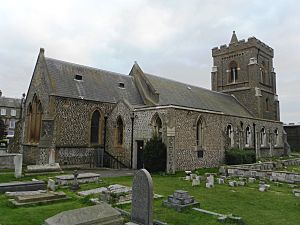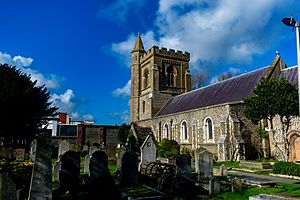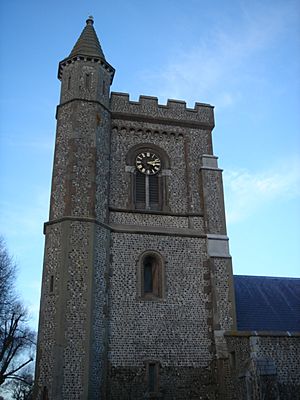St Andrew's Church, Church Road, Hove facts for kids
Quick facts for kids St Andrew (Old Church), Hove |
|
|---|---|

The church from the northeast
|
|
| Denomination | Church of England |
| Churchmanship | Broad Church |
| History | |
| Dedication | Saint Andrew |
| Administration | |
| Parish | Hove, St Andrew (Old Church) |
| Deanery | Hove |
| Archdeaconry | Brighton and Lewes |
| Diocese | Chichester |
| Province | Canterbury |
St Andrew's Church is an Anglican church located on Church Road in Hove, a city in England. People often call it St Andrew (Old Church) to tell it apart from another St Andrew's Church nearby. For many centuries, this church was the main parish church for Hove. However, the building was almost a ruin until Hove started to grow into a popular place to live in the early 1800s.
Contents
The Church's Story
Hove grew up separately from its neighbour, Brighton. It started as a small village with one main street. A church was built in the Middle Ages, maybe around the 1100s. It was in a quiet spot in the fields, away from the village.
Early Days and Challenges
The first church building was replaced with a simple Norman-style church. It had a main area (nave) with aisles and a tower. By the 1200s, a chancel (the part of the church where the altar is) was added. This church was the main one for Hove until 1531. At that time, Hove joined with the nearby area of Preston.
After this, fewer people lived in the area, and it became hard to keep the church in good shape. By the 1700s, parts of the church were falling apart. The roof was damaged, and the tower even fell down in 1801.
Hove Grows and the Church is Rebuilt
Things started to get better for the church in the early 1800s. New homes were being built around the old village, like the Brunswick estate. Brighton had grown so much that new buildings had to be in Hove. Because of this, Hove's population jumped from just 100 people in 1801 to 2,500 by 1841. By 1871, it reached 11,000!
With so many new people, church leaders knew they needed to fix St Andrew's. In 1833, they decided to restore the old church instead of building a new one somewhere else.
Architect George Basevi was asked to figure out how much it would cost. The rebuilding started in 1834. A company from London, Butler & Green, did the construction work following Basevi's plans. The project had a tight budget.
St Andrew's Church reopened on July 18, 1836. It could seat 430 people. Some seats were "pew rents," meaning people paid to have their own special seats. In 1839, a gallery was added at the back, making space for 200 more people.
Changes in Parish Status
In 1878, the combined parish of Hove-cum-Preston was split again. St Andrew's became the main parish church for Hove once more. However, the new vicar, Rev. Thomas Peacey, wanted a brand new church. This led to the building of All Saints Church in 1892. After that, St Andrew's became a smaller church, helping out All Saints, until it got its own parish again in 1957.
The Churchyard Over Time
Old maps show that in 1844, the church was in the middle of a square-shaped churchyard. By 1873, the churchyard had grown much larger, becoming a long rectangle.
Sadly, the churchyard was made smaller twice, and some old graves were lost. In 1880, Church Road was made wider, taking away ten feet from the south side of the churchyard. In 1972, a school was built, and a lot of land on the north side was used for it. More graves were moved when the parish hall was built in one corner of the grounds.
Church Design and Features
St Andrew's Church was rebuilt in 1834. It has a special design called "Neo-Norman." This style brings back the look of original Norman buildings from the 1000s and 1100s. Even though the outside was rebuilt, some original Norman parts were kept inside. These old parts might have influenced George Basevi's design.
Inside, you can still see round columns, pointed arches, and parts of the roof from the Middle Ages. The old box-pews (enclosed seats) and the pulpit (where the sermon is given) were replaced in 1879. A new font (for baptisms) was put in in 1865. In 1953, a lychgate (a covered gateway to a churchyard) was added on the south side.
Important Graves and Memorials

Many famous people have been buried at St Andrew's Church, though not all their graves are still there. Others are remembered with special plaques inside the church.
- The artist Copley Fielding was buried here in 1855. He has a memorial plaque inside the church.
- The Vallance family, who were important landowners in Hove for 150 years, have their family tomb outside the church.
- The family of George Basevi, the church's architect, also has a tomb inside.
- Brighton architect Charles Busby was buried in the churchyard, but his tomb was moved when Church Road was widened.
- Rev. Walter Kelly, a former vicar, is buried in the churchyard and has a memorial stone inside.
- The Elliott family, another important church family from Brighton, has a tomb in the churchyard. This includes Charlotte Elliott, who wrote hymns.
- Sir George Everest, the famous geographer who measured the world's highest mountain (which was named after him), is buried here. He died in London in 1866. He had no known connection to Hove or Brighton.
- George Augustus Westphal, the last naval officer who served on The Victory at the Battle of Trafalgar, is buried in the churchyard. There is a plaque for him inside the church.
- Another Trafalgar veteran, Rear-Admiral Sir John Hindmarsh, the first Governor of South Australia, is also buried here.
- There are also special memorials for soldiers from World War I and World War II.
St Andrew's Church Today
St Andrew's Church is a Grade II* listed building. This means it is a very important historical building. As of February 2001, it was one of 70 such buildings in Brighton and Hove.
The church holds services every day, including two main services on Sunday mornings. They also have activities for children and young people, like a Sunday school.
More to Explore
- Grade II* listed buildings in Brighton and Hove
- List of places of worship in Brighton and Hove


